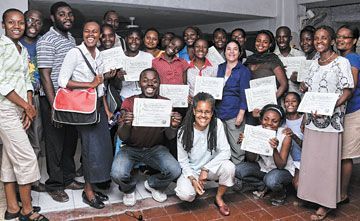Whether you accept it, avoid it or live somewhere in between, insurance coverage has become a defining issue for our profession. Patients increasingly expect to use their benefits, practitioners want to be compensated fairly for their time and expertise, and the system itself remains – at best – fragmented. The encouraging news is that coverage has expanded in meaningful ways. The challenging news is that reimbursement, across the board, remains inadequate.
AWB Training Trip to Haiti Proves Successful
After the Haiti earthquake in January, Acupuncturists Without Borders raised funds and sent eight volunteer teams to provide approximately 4,500 trauma recovery treatments in Haiti under the supervision of AWB Haiti Operations Manager Julia Raneri and Volunteer Coordinator Diane Eggleston. When doctors, nurses, and other healthcare providers saw how beneficial these treatments were for their patients, they requested that AWB come and train them in this methodology.
AWB's first training trip to Haiti took place in August of 2010, with trainers Julia Raneri and Doris Owanda-Johnson training 30 health care providers. Some of the training manual information was generously provided by the National Acupuncture Detoxification Association and NADA Registered Trainers Beth Cole and Megan Yarberry from a training they had previously presented in Haiti.
Many of the practitioners AWB trained in August 2010 requested that AWB return for a follow-up training trip. The Unitarian Universalist Service Committee funded this return training trip, which took place from May 27 - May 30, again under the supervision of Julia Raneri and Doris Owanda-Johnson.

A total of 33 students were trained during the four-day training in May, 2011. Of these, nine were returning students who had been previously trained by AWB in August of 2010. The returning students were primarily nurses and psychologists from the general hospital. Of the new students, 11 were staff people from Partners in Health, a non-governmental organization providing health care at facilities around Haiti, and most of these were psychologists. Four other new students were health care providers from the Kay La Sante clinic in Port-au-Prince which is run by Johanna Berrigan. The others were nurses, psychologists, a dentist, and a midwife.
Applying Training Methods
Of the 30 students trained in August, 2010, all nine of the students who returned for follow-up training in May had provided treatments after the training. Some had treated family and friends. Others had been able to provide treatments for their clients in their work as psychologists. One of the trainees has a free clinic every Saturday out of her home where she has delivered hundreds of free treatments for members of the public. Other venues where these students have offered treatments include: Matthew 25 house and the General Hospital in Port-au-Prince, and the evacuee camp in Leogane.

All of the students who have treated said they have had good results. Their general sentiment expressed at the May training was: "The people of Haiti are getting on with their lives and moving past their trauma - and the treatment is a big support in the general healthcare of the people." However, they have not been able to treat as much as they hoped to because they have not yet been able to fully integrate the ear treatments into their paid work.
Early on in the May training, trainers Doris Owanda-Johnson and Julia Raneri treated each student so they would have the experience of receiving the treatment. Students learned some basics of the history and philosophy of Chinese Medicine, and quickly moved into studying the five-point National Acupuncture Detoxification Association (NADA) protocol. They practiced point location on each other using golf tees. Then they had an opportunity to treat each other and receive input and correction from Julia and Doris. They also treated Julia and Doris so the trainers could experience their needle technique first-hand and offer additional feedback.
By the third day, trainees were ready to provide supervised treatments to the public and treatment kits were handed out amidst much excitement. The students had an opportunity to treat over 200 members of the general public, under supervision from Doris and Julia. By graduation on the fourth day both the students and the trainers were confident that the trainees were ready to provide ongoing treatments for the general public.
Proposed Next Steps

In order to fully implement this program in Haiti with more widespread results and success, AWB is working to create a plan with a local non-governmental organization that is committed to supporting and developing this work. AWB is also seeking recognition for ear acupuncture treatment by the Ministry of Health, with the possibility of passing legislation to endorse NADA treatments by those who have received training. Some of the practitioners who have been trained by AWB also hope to create an association in Haiti, and AWB will support this effort. AWB also intends to seek additional funding to train other practitioners who are affiliated with a host NGO once this type of partnership has been established. If possible, AWB would like to be able to offer payment for a part-time team leader who can coordinate the efforts of local practitioners, as well as additional follow-up training and support for ear acupuncture practitioners.


